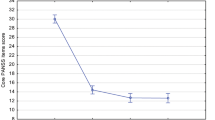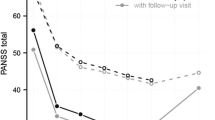Abstract
Aim of the study was to examine the course of schizophrenia patients within 2 years after discharge. Within a multicenter study of the German Competence Network on Schizophrenia, patients suffering from a schizophrenia spectrum disorder were examined regarding their psychopathological improvement, tolerability, and the treatment regime applied during hospitalization and a 2-year follow-up period. Response, remission, the level of everyday functioning, and relapse were furthermore evaluated during the follow-up period using established definitions for these outcome domains. The psychopharmacological treatment was specifically evaluated in terms of a potential association with relapse. 149 patients were available for analysis, with 65% of the patients being in response, 52% in symptomatic remission, and 64% having a satisfiable everyday functioning 2 years after their discharge from hospital. Despite these favorable outcome rates, 63% of the patients suffered from a relapse within the 2-year follow-up period with 86% of these patients being rehospitalized. Discharge non-responder and non-remitter were twice as likely to relapse during follow-up. A significant decrease of side-effects was observed with negligible rates of extrapyramidal side-effects, sedation, and weight gain during follow-up. Patients receiving treatment with atypical antipsychotics were found to have the lowest risk to relapse (p < 0.0001). The results highlight the natural and unsteady course of schizophrenia in most patients underlining the need to develop more specific treatment strategies ensuring ongoing stability and preventing relapse.





Similar content being viewed by others

References
Ciudad A, Alvarez E, Bobes J, San L, Polavieja P, Gilaberte I (2009) Remission in schizophrenia: results from a 1-year follow-up observational study. Schizophr Res 108:214–222
Bobes J, Ciudad A, Alvarez E, San L, Polavieja P, Gilaberte I (2009) Recovery from schizophrenia: results from a 1-year follow-up observational study of patients in symptomatic remission. Schizophr Res 115:58–66
Herceg M, Jukic V, Vidovic D, Erdeljic V, Celic I, Kozumplik O, Bagaric D, Silobrcic RM (2008) Two-year rehospitalization rates of patients with newly diagnosed or chronic schizophrenia on atypical or typical antipsychotic drugs: retrospective cohort study. Croat Med J 49:215–223
Haro JM, Novick D, Suarez D, Ochoa S, Roca M (2008) Predictors of the course of illness in outpatients with schizophrenia: a prospective three year study. Prog Neuropsychopharmacol Biol Psychiatry 32:1287–1292
Leucht S, Heres S, Hamann J, Kane JM (2008) Methodological issues in current antipsychotic drug trials. Schizophr Bull 34:275–285
Leucht S, Kane JM (2006) Measurement-based psychiatry: definitions of response, remission, stability, and relapse in schizophrenia. J Clin Psychiatry 67:1813–1814
Leucht S, Davis JM, Engel RR, Kissling W, Kane JM (2009) Definitions of response and remission in schizophrenia: recommendations for their use and their presentation. Acta Psychiatr Scand Suppl 119:7–14
Helldin L, Kane JM, Hjarthag F, Norlander T (2009) The importance of cross-sectional remission in schizophrenia for long-term outcome: a clinical prospective study. Schizophr Res 115:67–73
Stroup TS (2007) Heterogeneity of treatment effects in schizophrenia. Am J Med 120:S26–S31
Tunis SR, Stryer DB, Clancy CM (2003) Practical clinical trials: increasing the value of clinical research for decision making in clinical and health policy. JAMA 290:1624–1632
Wolwer W, Buchkremer G, Hafner H, Klosterkotter J, Maier W, Moller HJ, Gaebel W (2003) German research network on schizophrenia-bridging the gap between research and care. Eur Arch Psychiatry Clin Neurosci 253:321–329
Jager M, Riedel M, Messer T, Laux G, Pfeiffer H, Naber D, Schmidt LG, Gaebel W, Huff W, Heuser I, Kuhn KU, Lemke MR, Ruther E, Buchkremer G, Gastpar M, Bottlender R, Strauss A, Moller HJ (2007) Psychopathological characteristics and treatment response of first episode compared with multiple episode schizophrenic disorders. Eur Arch Psychiatry Clin Neurosci 257:47–53
American Psychiatric Association (1994) Diagnostic and Statistical Manual of Mental Disorders, 4th edn. American Psychiatric Association, Washington DC
Cording C (1998) Conceptual aspects in development and implementation of basic psychiatric documentation. Psychiatr Prax 25:175–178
Kay SR, Opler LA, Lindenmayer JP (1988) Reliability and validity of the positive and negative syndrome scale for schizophrenics. Psychiatry Res 23:99–110
Hamilton M (1960) A rating scale for depression. J Neurol Neurosurg Psychiatry 23:56–62
Kemp R, David A (1996) Psychological predictors of insight and compliance in psychotic patients. Br J Psychiatry 169:444–450
Lingjaerde O, Ahlfors UG, Bech P, Dencker SJ, Elgen K (1987) The UKU side effect rating scale. A new comprehensive rating scale for psychotropic drugs and a cross-sectional study of side effects in neuroleptic-treated patients. Acta Psychiatr Scand Suppl 334:1–100
Leucht S, Davis JM, Engel RR, Kane JM, Wagenpfeil S (2007) Defining ‘response’ in antipsychotic drug trials: recommendations for the use of scale-derived cutoffs. Neuropsychopharmacology 32:1903–1910
Obermeier M, Mayr A, Schennach-Wolff R, Seemuller F, Moller HJ, Riedel M (2009) Should the PANSS be rescaled? Schizophr Bull 36:455–460
Andreasen NC, Carpenter WT Jr, Kane JM, Lasser RA, Marder SR, Weinberger DR (2005) Remission in schizophrenia: proposed criteria and rationale for consensus. Am J Psychiatry 162:441–449
Bachmann S, Bottmer C, Schroder J (2008) One-year outcome and its prediction in first-episode schizophrenia—a naturalistic study. Psychopathology 41:115–123
Harrington DP, Fleming TR (1982) A class of rank test procedures for censored survival data. Biometrika 69:553–566
Stauffer V, Case M, Kollack-Walker S, Scher-Svanum H, Ball T, Kapur S, Kinon BJ (2011) Trajectories of response to treatment with atypical antipsychotic medication in patients with schizophrenia pooled from 6 double-blind, randomized clinical trials. Schizophr Res 130:11–19
Levine SZ, Leucht S (2010) Elaboration on the early-onset hypothesis of antipsychotic drug action: treatment response trajectories. Biol Psychiatry 68:86–92
Addington J, Leriger E, Addington D (2003) Symptom outcome 1 year after admission to an early psychosis program. Can J Psychiatry 48:204–207
Zisook S, McAdams LA, Kuck J, Harris MJ, Bailey A, Patterson TL, Judd LL, Jeste DV (1999) Depressive symptoms in schizophrenia. Am J Psychiatry 156:1736–1743
Moller HJ, Jager M, Riedel M, Obermeier M, Strauss A, Bottlender R (2010) The Munich 15-year follow-up study (MUFUSSAD) on first-hospitalized patients with schizophrenic or affective disorders: comparison of psychopathological and psychosocial course and outcome and prediction of chronicity. Eur Arch Psychiatry Clin Neurosci 260:367–384
Beitinger R, Lin J, Kissling W, Leucht S (2008) Comparative remission rates of schizophrenic patients using various remission criteria. Prog Neuropsychopharmacol Biol Psychiatry 32:1643–1651
Karow A, Moritz S, Lambert M, Schottle D, Naber D (2011) Remitted but still impaired? Symptomatic versus functional remission in patients with schizophrenia. Eur Psychiatry 27:401–405
Wunderink L, Nienhuis FJ, Sytema S, Wiersma D (2007) Predictive validity of proposed remission criteria in first-episode schizophrenic patients responding to antipsychotics. Schizophr Bull 33:792–796
San L, Ciudad A, Alvarez E, Bobes J, Gilaberte I (2007) Symptomatic remission and social/vocational functioning in outpatients with schizophrenia: prevalence and associations in a cross-sectional study. Eur Psychiatry 22:490–498
Schennach-Wolff R, Jager M, Seemuller F, Obermeier M, Messer T, Laux G, Pfeiffer H, Naber D, Schmidt LG, Gaebel W, Huff W, Heuser I, Maier W, Lemke MR, Ruther E, Buchkremer G, Gastpar M, Moller HJ, Riedel M (2009) Defining and predicting functional outcome in schizophrenia and schizophrenia spectrum disorders. Schizophr Res 113:210–217
Schooler NR (2003) Relapse and rehospitalization: comparing oral and depot antipsychotics. J Clin Psychiatry 64(Suppl 16):14–17
Bosveld-van Haandel LJ, Slooff CJ, van den Bosch RJ (2001) Reasoning about the optimal duration of prophylactic antipsychotic medication in schizophrenia: evidence and arguments. Acta Psychiatr Scand 103:335–346
Schennach-Wolff R, Moller HJ, Jager M, Seemuller F, Obermeier M, Messer T, Laux G, Pfeiffer H, Naber D, Schmidt LG, Gaebel W, Klosterkotter J, Heuser I, Maier W, Lemke MR, Ruther E, Klingberg S, Gastpar M, Riedel M (2010) A critical analysis and discussion of the appropriateness of the schizophrenia consensus remission criteria in clinical pharmaceutical trials. Pharmacopsychiatry 43:245–251
Falkai P, Wobrock T, Lieberman J, Glenthoj B, Gattaz WF, Moller HJ (2005) World Federation of Societies of Biological Psychiatry (WFSBP) guidelines for biological treatment of schizophrenia, part 1: acute treatment of schizophrenia. World J Biol Psychiatry 6:132–191
de Sena EP, Santos-Jesus R, Miranda-Scippa A, Quarantini LC, Oliveira IR (2003) Relapse in patients with schizophrenia: a comparison between risperidone and haloperidol. Rev Bras Psiquiatr 25:220–223
Rabinowitz J, Lichtenberg P, Kaplan Z, Mark M, Nahon D, Davidson M (2001) Rehospitalization rates of chronically ill schizophrenic patients discharged on a regimen of risperidone, olanzapine, or conventional antipsychotics. Am J Psychiatry 158:266–269
Istvan S, Agoston T, Tamas T, Zoltan J (2007) A naturalistic, observational study of outpatients with schizophrenia: efficacy and safety results after 6 months. The International Schizophrenia Outpatient Health Outcomes study, IC-SOHO. Neuropsychopharmacol Hung 9:115–124
Haro JM, Novick D, Suarez D, Roca M (2009) Antipsychotic treatment discontinuation in previously untreated patients with schizophrenia: 36-month results from the SOHO study. J Psychiatr Res 43:265–273
Ascher-Svanum H, Zhu B, Faries D, Landbloom R, Swartz M, Swanson J (2006) Time to discontinuation of atypical versus typical antipsychotics in the naturalistic treatment of schizophrenia. BMC Psychiatry 6:8
Hugenholtz GW, Heerdink ER, Nolen WA, Egberts AC (2004) Less medication switching after initial start with atypical antipsychotics. Eur Neuropsychopharmacol 14:1–5
Dossenbach M, Rango-Davila C, Silva IH, Landa E, Aguilar J, Caro O, Leadbetter J, Assuncao S (2005) Response and relapse in patients with schizophrenia treated with olanzapine, risperidone, quetiapine, or haloperidol: 12-month follow-up of the Intercontinental Schizophrenia Outpatient Health Outcomes (IC-SOHO) study. J Clin Psychiatry 66:1021–1030
Alptekin K, Aydin H, Gucer KM, Dilbaz N, Goka E, Esendemir C, Oguz H, Arabul G, Aslaner F, Ayer A, Celiker AR, Cirit H, Pinar Z, Unal A (2010) Patient adherence and efficacy of quetiapine treatment in schizophrenia: results of a multicentre, naturalistic 6-month follow-up study. Int Clin Psychopharmacol 25:342–348
Martin JL, Perez V, Sacristan M, Rodriguez-Artalejo F, Martinez C, Alvarez E (2006) Meta-analysis of drop-out rates in randomised clinical trials, comparing typical and atypical antipsychotics in the treatment of schizophrenia. Eur Psychiatry 21:11–20
Funding
The study was performed within the framework of the German Research Network on Schizophrenia, which is funded by the German Federal Ministry for Education and Research BMBF (Grant 01 GI 0233).
Author information
Authors and Affiliations
Corresponding author
Ethics declarations
Conflict of interest
The authors declare that they have no conflict of interest within the context of this study.
Rights and permissions
About this article
Cite this article
Schennach, R., Riedel, M., Obermeier, M. et al. What happens with schizophrenia patients after their discharge from hospital? Results on outcome and treatment from a “real-world” 2-year follow-up trial. Eur Arch Psychiatry Clin Neurosci 270, 661–671 (2020). https://doi.org/10.1007/s00406-019-01055-4
Received:
Accepted:
Published:
Issue Date:
DOI: https://doi.org/10.1007/s00406-019-01055-4



